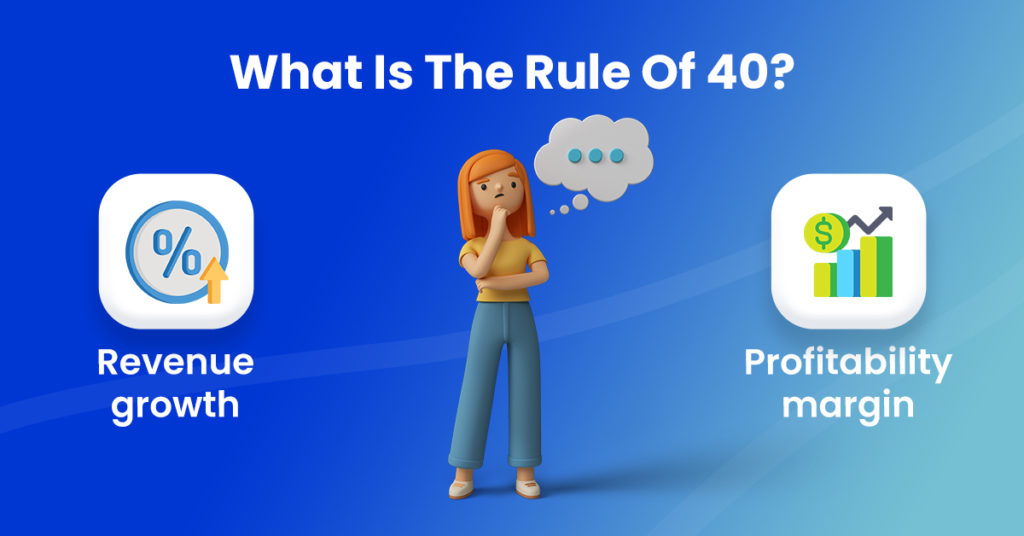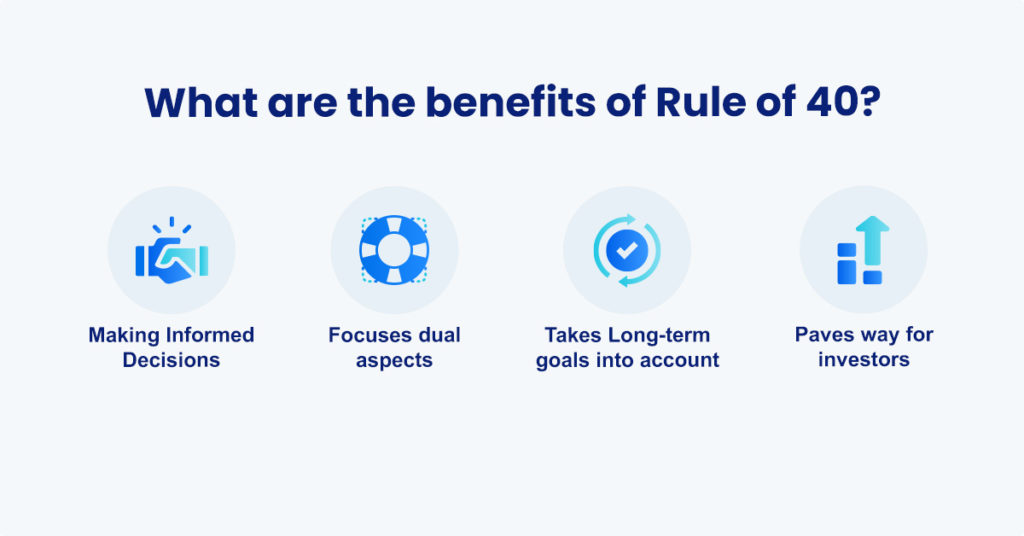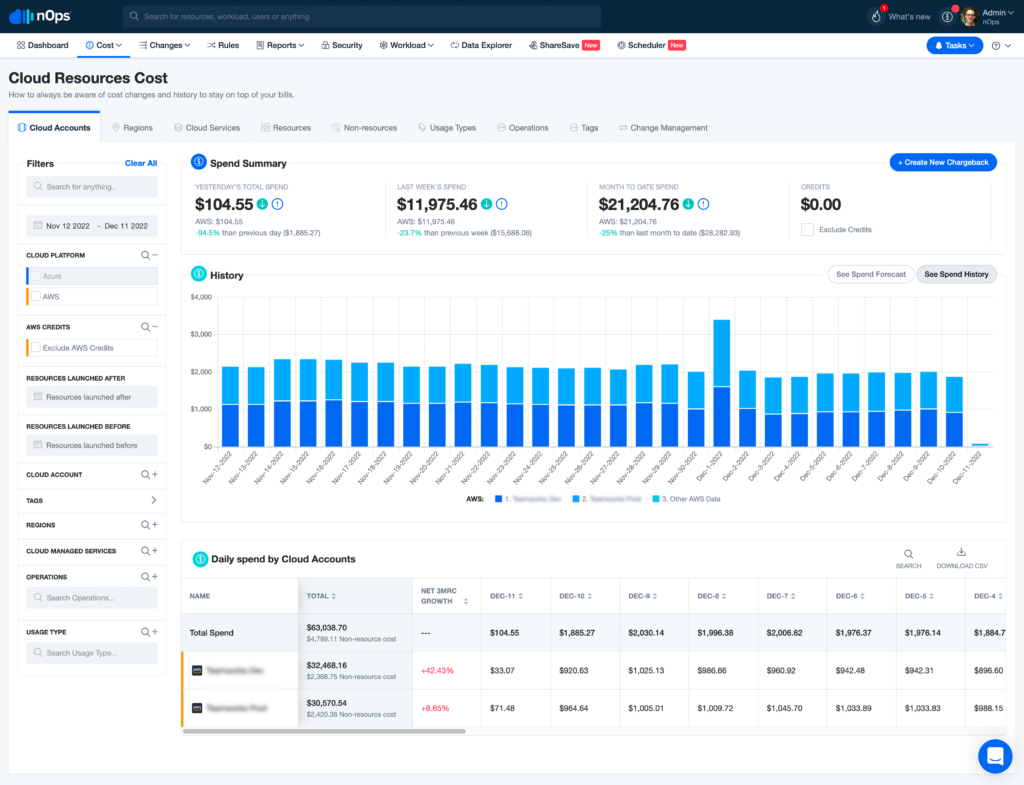Understanding The Rule of 40 for SaaS: Basics, Calculation, and Advantages
As software as a service (SaaS) businesses continue to gain traction in the market, they are faced with the challenge of creating a successful business model and achieving profitability. The Rule of 40 is a key metric used to measure the success of software-as-a-service (SaaS) companies. It was first proposed in 2011 by venture capitalist Fred Wilson and has since become a widely used measure of success for SaaS businesses. The Rule of 40 states that a SaaS business should have a combined total of at least 40 percent growth in revenue and profitability to be successful.
The Rule of 40 SaaS metrics is especially popular among venture capitalists, as it gives them a quick and easy way to gauge how a company is performing. It can also be used by entrepreneurs and business owners to assess the health of their businesses. In this blog, we will look at the basics of the Rule of 40, how to calculate it, and the advantages of using this metric for SaaS businesses. Let’s get started:
What is the Rule of 40?

The Rule of 40 states that a SaaS business should have a combined total of at least 40 percent growth in revenue and profitability to be successful. In other words, the combined growth of revenue and profitability should be 40 percent or more. This metric is used to measure the success of SaaS businesses, and it is based on the idea that the combination of revenue growth and profitability growth can provide a better indication of a SaaS business’s success than either metric alone.
The idea behind the rule is that a company should strive for a balance between growth and profitability. It is important for companies to grow quickly in order to capture market share and create value, but it is just as important to be profitable so that the company can sustain its growth and ensure its long-term success. The Rule of 40 SaaS is a way of measuring this balance.
How to Calculate the Rule of 40?
Here is the step-by-step guide on Rule of 40 calculation:

Step 1: Gather the Necessary Data
The first step in calculating the Rule of 40 is to gather the necessary data. This includes the company’s total revenue for the most recent fiscal year, its revenue growth rate for the same period, and its operating margin percentage. The operating margin percentage is the company’s net income divided by its total revenue.
For example, let’s say that a company had total revenue of $100 million in its most recent fiscal year and an operating margin percentage of 10%. This would mean that the company’s net income was $10 million.
Step 2: Calculate the Revenue Growth Rate
The next step in rule of 40 calculation, is to calculate the company’s revenue growth rate for the same fiscal year. This is done by subtracting the company’s total revenue for the prior fiscal year from its total revenue for the most recent fiscal year and then dividing the result by the company’s total revenue for the prior fiscal year.
For example, if the company’s total revenue for the prior fiscal year were $90 million, then the revenue growth rate would be 11.11% ($100 million – $90 million / $90 million).
Step 3: Calculate the Rule of 40
Once you have the necessary data, you can calculate the Rule of 40. This is done by adding the company’s revenue growth rate to its operating margin percentage. In the example above, the company’s Rule of 40 would be 21.11% (11.11% + 10%).
If the result is above 40, then the company is generally viewed as being in a good position. However, if the result is below 40, then the company may need to adjust its strategy in order to improve its performance.
Advantages of the Rule of 40 for SaaS Businesses
The Rule of 40 is advantageous for SaaS businesses because of the following reasons:

- Making Informed Decisions: It provides a simple yet effective way to measure success. By adding together the growth rate and profitability rate, the Rule of 40 gives a clear indication of the business’s financial health. This allows business owners to quickly assess their performance and make informed decisions about their future.
- Focuses dual aspects: The Rule of 40 is also advantageous because it takes into account both growth and profitability. When evaluating the performance of a business, it is important to consider both factors. The Rule of 40 ensures that businesses are not only focused on growth but also on profitability.
- Takes Long-term goals into account: Furthermore, the Rule of 40 is advantageous because it encourages businesses to focus on long-term success. By aiming for a score of 40 percent or higher, businesses are incentivized to focus on sustainable growth and profitability rather than short-term gains. This helps businesses to create a strong foundation for the future and ensure long-term success.
- Paves way for investors: Finally, the Rule of 40 is advantageous because it can help businesses to attract investors. Many venture capitalists use the Rule of 40 as a measure of success when evaluating potential investments. By reaching a score of 40 percent or higher, businesses can demonstrate to investors that they have a successful and profitable business model.
How nOps can help with Rule of 40 SaaS?

To pace up with the growth rate and the profitability of the SaaS business, Cloud Cost Optimization has to be prioritized. To analyze each different aspect of cost insights, nOps ShareSave can help you consolidate cloud accounts into a single pricing model and offer ongoing visibility to change requests. This helps you easily manage cloud costs and save more money.
Plus, with nOps Cloud Cost Optimization, you can save more by centralizing cloud accounts into a consolidated billing model, providing instant and continuous visibility to change requests and delta to your infrastructure that cause cost, and giving you the best root cause analysis capabilities available anywhere.



